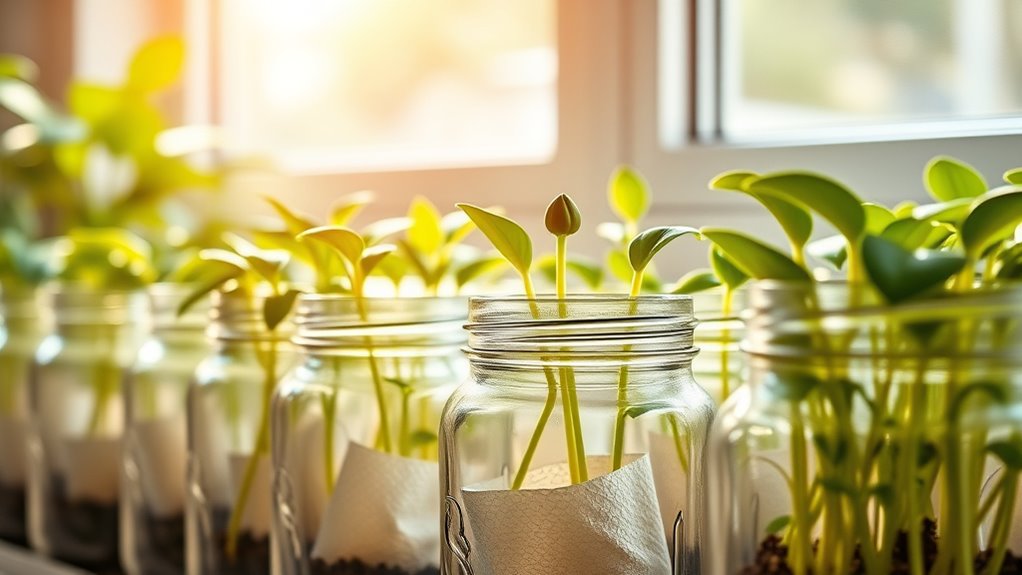To safely sprout at home in 2025, choose organic, non-GMO seeds labeled for sprouting and store them in a cool, dry place. Properly sterilize your equipment, rinse seeds thoroughly, and soak them in vinegar solutions before sprouting. Keep your environment clean, monitor for mold or odor, and rinse sprouts regularly. Store finished sprouts properly and consume within a few days. Keep following these tips for healthy, contamination-free sprouts. More details can help you master safe sprouting steps.
Key Takeaways
- Select certified, non-treated seeds suitable for sprouting and store them in cool, dry, airtight containers to prevent contamination.
- Properly sterilize all sprouting equipment with hot water, disinfectants, and ensure thorough drying before use.
- Maintain optimal sprouting conditions: 65-75°F temperature, proper humidity, indirect light, and frequent rinsing to prevent mold.
- Regularly inspect sprouts for odors, discoloration, or sliminess; discard contaminated sprouts immediately to ensure safety.
- Rinse sprouts thoroughly before consumption, store in breathable containers, and consume within 3-4 days for maximum safety.
Choosing the Right Seeds for Safe Sprouting

When selecting seeds for sprouting, it’s essential to choose those that are specifically labeled as safe for this purpose. Proper seed selection ensures your sprouts grow healthy and free from harmful contaminants. Look for seeds that are organic, non-GMO, and intended for sprouting, as these are less likely to carry pesticides or pathogens. Check for certification or trusted brands that prioritize safety. Germination tips are also vital—some seeds require soaking before sprouting, while others don’t. Avoid seeds with coatings or treatments not meant for sprouting. Additionally, understanding the role of seed quality in sprouting success helps you make informed choices. Using high-quality seeds can also reduce the risk of introducing contaminants into your home sprouting setup. The safety standards associated with seed production are crucial in ensuring your sprouts are healthy and safe to consume. Ensuring proper seed storage also plays a role in maintaining seed viability and safety. By carefully choosing the right seeds, you set a strong foundation for safe and successful sprouting at home. Remember, quality seed selection directly impacts your overall sprouting experience and health.
Preparing Your Sprouting Equipment Properly
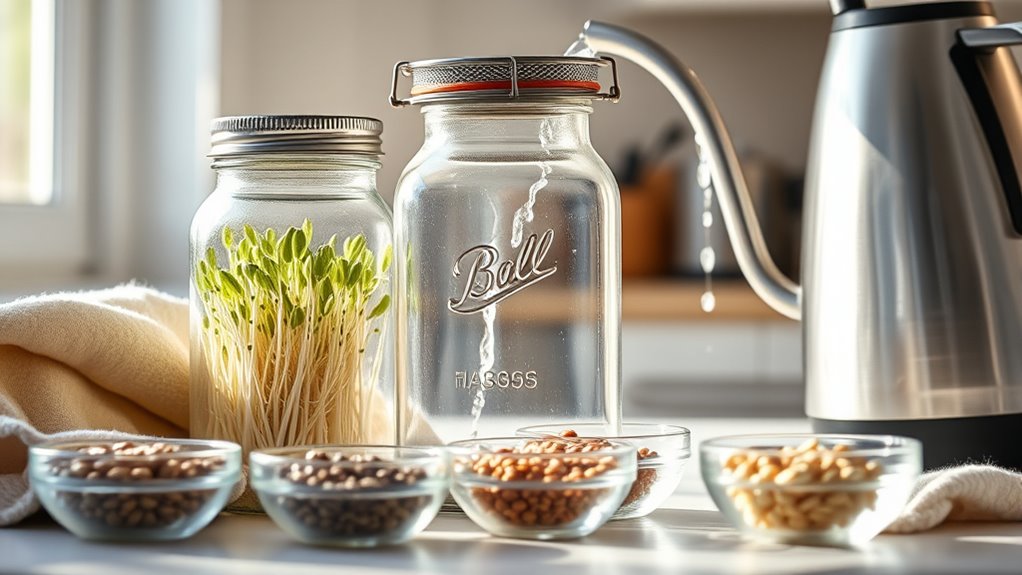
Before you start sprouting, make sure your equipment is thoroughly sterilized to prevent bacteria. Always use fresh, clean water to keep your process safe and your sprouts healthy. Properly preparing your tools sets the foundation for a successful and safe sprouting experience. Additionally, understanding food safety guidelines helps ensure your sprouts remain healthy and free from contamination.
Sterilize Equipment Thoroughly
To guarantee your sprouts grow healthy and free from contaminants, you need to sterilize your equipment thoroughly. Proper sterilization prevents bacteria and mold from compromising your sprouting process. First, wash all equipment with hot, soapy water to remove dirt and residue. Next, sterilize using boiling water or a food-safe disinfectant, ensuring all surfaces are covered. A sterilization technique that effectively eliminates microbes is essential for successful sprouting. Finally, dry the equipment completely before use to prevent mold growth. Remember, clean equipment also helps preserve seed storage quality and ensures fresh sprout packaging. Keep your sprouting tools in a sanitized container or designated area to maintain hygiene. Additionally, understanding the importance of sterilization techniques ensures you effectively eliminate harmful microbes. By taking these steps, you create a safe environment for your sprouts, reducing the risk of contamination and promoting healthy growth from seed to harvest.
Use Fresh, Clean Water
Have you ever considered how the water you use can impact your sprouts? Using fresh, clean water is vital for healthy sprouting. Water quality directly affects the growth and safety of your sprouts, so always choose filtered or purified water whenever possible. Tap water with high chlorine levels can hinder sprout development or introduce bacteria. Additionally, pay attention to water temperature—lukewarm water around room temperature is ideal for rinsing and soaking seeds, as it encourages sprout growth without shocking the seeds. Avoid using cold or hot water, which can slow or damage the process. Regularly change the water during rinsing to prevent bacterial buildup. Proper water filtration is essential for removing contaminants and ensuring the safety of your sprouts. By ensuring your water is fresh and clean, you set a solid foundation for safe, healthy sprouts. Additionally, using appropriate water quality can prevent the introduction of harmful bacteria that may compromise your sprouting process.
Understanding the Optimal Sprouting Conditions
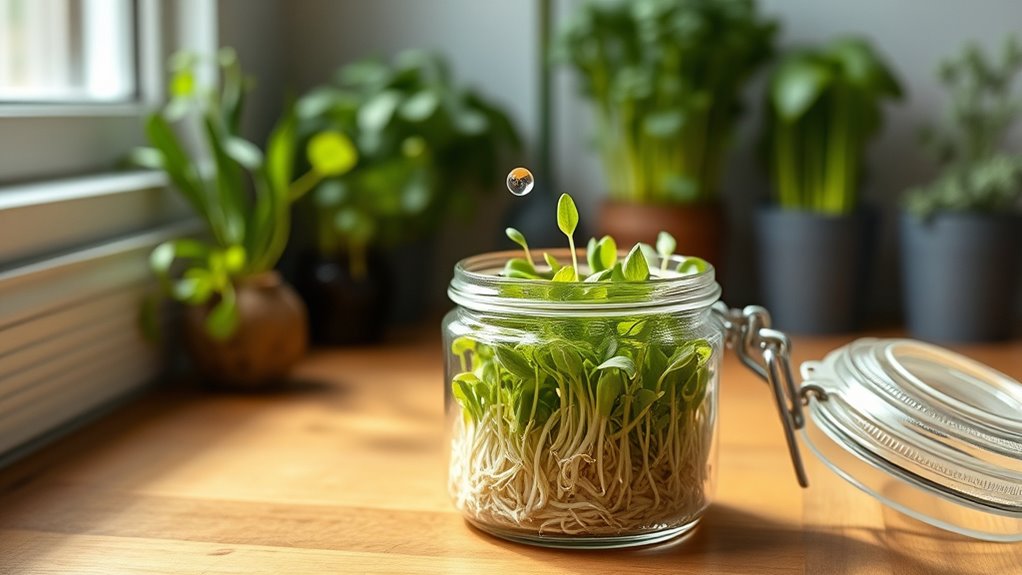
Achieving successful sprouting at home depends on creating the right environment, which involves managing temperature, moisture, and light. To optimize seed germination and maximize sprouting nutrition, you should aim for consistent conditions.
- Keep the temperature between 65-75°F, as this range encourages healthy seed germination.
- Maintain damp but not soaked moisture levels to prevent mold and ensure roots develop properly.
- Provide indirect light or a bright spot—direct sunlight can dry out sprouts or cause overheating.
Step-by-Step Guide to Sanitizing Your Seeds and Equipment

Before you begin sprouting, proper sanitation of your seeds and equipment is essential to prevent mold and bacterial growth. Start by rinsing your seeds thoroughly to remove dirt and debris, then soak them in a vinegar solution (one part vinegar to three parts water) for 5-10 minutes. This step helps eliminate bacteria and mold spores. Rinse the seeds again with clean water to remove any vinegar residue. Clean all your sprouting containers, mesh trays, and utensils with hot, soapy water, then disinfect with a solution of water and hydrogen peroxide or vinegar. Proper seed storage is critical; keep seeds in a cool, dry place to prevent contamination. It is also beneficial to monitor environmental conditions such as humidity and temperature during sprouting to ensure optimal growth and reduce spoilage risks. Using an air purifier with a HEPA filter can help improve air quality in your sprouting area by reducing airborne mold spores and bacteria. Ensuring effective co-parenting plans are in place can also help maintain a stable environment for your children during the sprouting process. Sanitizing your tools and seeds ensures healthy sprout nutrition and reduces the risk of spoilage.
Best Practices for Soaking and Rinsing

Starting with proper soaking and rinsing sets the foundation for healthy sprouts. To guarantee seed viability, soak seeds in clean, filtered water for the recommended time—usually 8-12 hours. After soaking, rinsing is essential to remove any dirt and prevent mold.
Starting your sprouting journey with proper soaking and rinsing ensures healthy, safe sprouts from the very beginning.
Here are key practices:
- Rinse seeds thoroughly 2-3 times daily, maintaining consistent rinse frequency to keep seeds moist but not waterlogged.
- Use cool, clean water to prevent bacterial growth and preserve seed viability.
- Drain excess water completely after each rinse to avoid stagnation, which can hinder sprouting.
Sticking to these steps helps promote healthy sprout growth, reduces the risk of spoilage, and guarantees your sprouts are safe to eat.
Maintaining a Clean Sprouting Environment

Keeping your sprouting area clean is essential to prevent contamination and guarantee healthy growth. Regularly sanitize your sprouting containers, utensils, and surfaces to eliminate soil pathogens that can cause mold or bacterial issues. Store seeds in a cool, dry place in airtight containers to prevent exposure to dirt, pests, or mold spores, which can compromise seed quality. Avoid leaving residual water or organic debris around your sprouting setup, as these create breeding grounds for bacteria. Always wash your hands thoroughly before handling seeds or sprouts. Maintaining a tidy environment reduces the risk of cross-contamination and helps ensure your sprouts grow safely and healthily. Ensuring your seed storage practices are optimal can also significantly impact sprout quality and safety. Proper cleaning of your sprouting environment helps eliminate potential sources of contamination and promotes healthy sprout development. Regularly monitoring your growing conditions, such as humidity and airflow, can further support healthy sprout growth. Maintaining a tidy environment and proper seed storage are key to a successful, contamination-free sprouting process at home. Additionally, understanding merchant services and their security measures can help protect your business from potential risks associated with payment processing.
Monitoring for Signs of Contamination
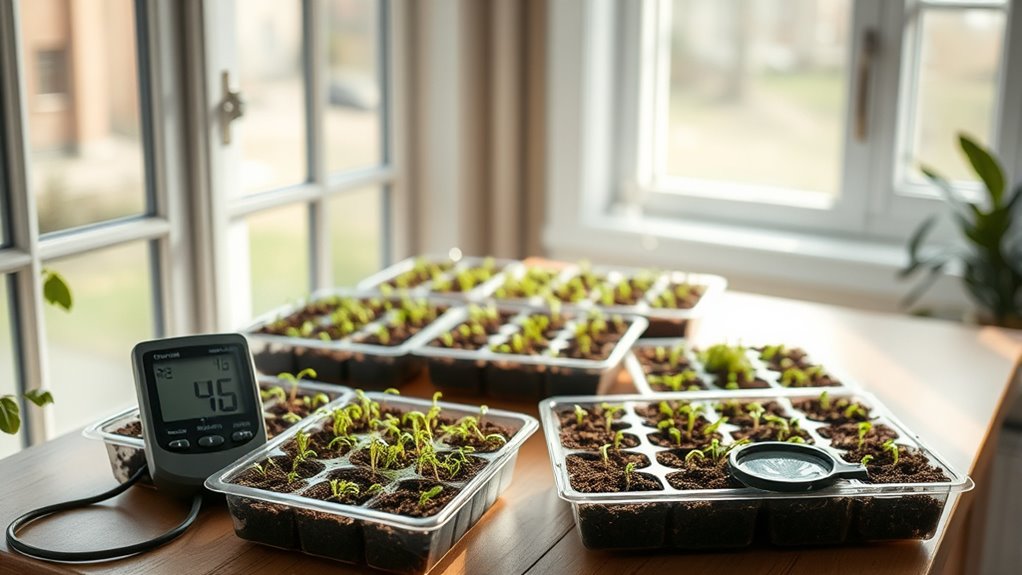
Monitoring your sprouts closely is crucial for catching signs of contamination early. Keep a sharp eye out for contamination indicators like unusual odors, discoloration, or slimy textures. Mold growth is a common concern, so watch for fuzzy patches or any fuzzy mold that appears on the surface. To stay vigilant: 1. Inspect your sprouts daily, focusing on smell, color, and texture. 2. Look for any fuzzy or discolored patches indicating mold growth. 3. Remove any contaminated sprouts immediately to prevent spreading. Regular monitoring aligns with good food safety practices and helps ensure your sprouts remain healthy and safe to eat. Employing proper hygiene protocols during handling further reduces contamination risks. Early detection is essential for preventing health risks associated with contaminated sprouts. Being aware of contamination signs can help you act swiftly to protect your health. If you notice any of these signs, discard the affected sprouts and sanitize your equipment. Early detection helps maintain a safe sprouting environment and ensures your sprouts stay healthy and edible. Staying attentive is your best defense against contamination.
Proper Storage and Handling of Sprouts

To keep your sprouts safe, always sanitize your equipment and surfaces before handling them. Store your sprouts in the refrigerator at the right temperature to prevent bacterial growth. Proper handling and refrigeration help guarantee your sprouts stay fresh and safe to eat.
Sanitizing Equipment and Surfaces
Are you aware of how essential proper sanitizing practices are for safe sprout handling? Keeping your equipment and surfaces sanitized prevents contamination and ensures safe sprouts. First, always clean and disinfect your sprouting containers after each use. Second, sanitize your work surfaces regularly, especially when handling seed selection or adding sprout seasoning. Third, wash your hands thoroughly before and after handling sprouts or equipment. Proper sanitizing minimizes bacteria and mold growth, reducing health risks. Remember, clean equipment helps maintain sprout quality, and sanitized surfaces prevent cross-contamination. By following these steps, you keep your sprouting environment safe and hygienic, promoting healthy, delicious sprouts every time.
Proper Refrigeration Techniques
Ever wondered how proper refrigeration keeps your sprouts fresh and safe? It all starts with seed selection—choose high-quality, organic seeds free from pathogens. Once your sprouts are ready, transfer them to clean, breathable sprouting containers designed for drainage. After rinsing thoroughly, drain excess water completely to prevent spoilage. Store your sprouts in the refrigerator at or below 40°F (4°C), ideally in a breathable container or a loosely covered container to allow airflow. Avoid airtight seals that trap moisture, which can promote bacteria growth. Keep sprouts separate from raw meats or other contaminated foods. Regularly check for spoilage, and only consume sprouts stored properly within a few days. Proper refrigeration and handling ensure your sprouts stay crisp, fresh, and safe to enjoy.
Recognizing and Avoiding Common Sprouting Mistakes
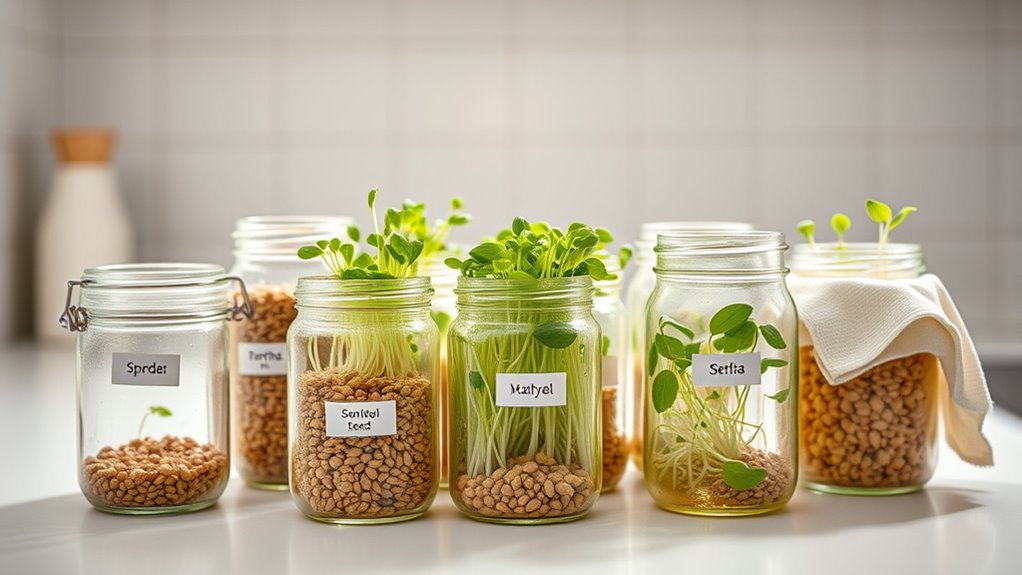
Sprouting at home can be rewarding, but it’s easy to make mistakes that compromise your harvest. One common error is choosing poor seed selection or incompatible sprout varieties, which can lead to mold or poor growth. To avoid this, always select high-quality seeds suited for sprouting and research the best varieties for your needs.
Here are key mistakes to watch for:
- Using old or contaminated seeds that can introduce bacteria.
- Failing to rinse sprouts thoroughly, creating a breeding ground for mold.
- Overcrowding sprouting containers, which limits airflow and causes spoilage.
Tips for Incorporating Sprouts Safely Into Your Diet

Incorporating sprouts safely into your diet is essential to enjoy their nutritional benefits without risking foodborne illness. First, choose high-quality seeds from reputable sources to ensure proper seed selection. Always rinse sprouts thoroughly before eating to remove any bacteria. Proper sprout storage is key; keep them refrigerated in a breathable container and consume within a few days. Avoid cross-contamination by washing hands and utensils after handling sprouts. Use this visual guide to help you maintain safety:
| Step | Action | Tips |
|---|---|---|
| Seed Selection | Buy from trusted suppliers | Check for freshness and quality |
| Rinsing | Rinse sprouts thoroughly before eating | Remove dirt and bacteria |
| Storage | Keep in fridge in breathable container | Consume within 3-4 days |
| Handling | Wash hands and utensils after touching | Prevent cross-contamination |
| Consumption Tips | Add to salads or sandwiches | Enjoy fresh and safe sprouted foods |
Frequently Asked Questions
How Long Should Sprouts Be Stored Safely After Harvesting?
When it comes to storage duration, you should aim to keep your sprouts for no more than 5 to 7 days after harvesting. Their shelf life decreases each day, so consume them promptly for ideal freshness and safety. Store sprouts in a breathable container in the refrigerator, and always check for any signs of spoilage before eating. Proper storage helps maintain their nutritional value and reduces the risk of contamination.
Are There Specific Pests or Insects That Threaten Sprouting Safety?
You should be aware that certain pests and insects can threaten your sprouting safety. Pest identification helps you recognize common intruders like aphids, fungus gnats, and thrips, which can contaminate your sprouts. To prevent insects, maintain cleanliness, use proper airflow, and avoid overwatering. Regular inspection is key—if you spot pests early, you can take swift insect prevention measures to keep your sprouts safe and healthy.
Can Indoor Air Quality Affect Sprout Safety and Growth?
Indoor air quality definitely affects sprout safety and growth. Airborne contaminants and indoor pollution can introduce bacteria, mold, or fungi that threaten healthy sprouting. You should guarantee good ventilation and keep your growing area clean to minimize airborne contaminants. Using air purifiers or opening windows regularly helps reduce indoor pollution, creating a safer environment for your sprouts. Maintaining clean air is essential for healthy, safe sprout development at home.
What Are the Signs of Spoiled or Unsafe Sprouts Before Consumption?
Think of your sprouts as a delicate garden; if it’s spoiled, warning signs appear. Look out for mold growth or a slimy texture, which signal they’re unsafe. Unpleasant odors or discoloration also indicate spoilage. Trust these signs like a gardener trusts their tools—if anything seems off, it’s best to discard the sprouts to avoid health risks. Always prioritize safety before enjoying your fresh, home-grown sprouts.
How Often Should Equipment Be Sanitized During Frequent Sprouting Cycles?
For frequent sprouting cycles, you should prioritize equipment maintenance and sanitation frequency to prevent contamination. Sanitize your sprouting tools and containers daily or after every few cycles, depending on your volume. Use hot water and food-safe disinfectants, ensuring everything is thoroughly dried before reuse. Regular cleaning helps eliminate bacteria and mold, keeping your sprouts safe and healthy for consumption. Consistent sanitation is key to successful home sprouting.
Conclusion
Sprouting at home is a healthy and rewarding practice, but safety should always come first. Did you know that improperly sprouted seeds can carry harmful bacteria, causing illness? By following these simple steps, you reduce that risk markedly. With just a bit of care, you can enjoy fresh, nutritious sprouts every time. Happy sprouting and stay safe—your health is worth it!
Aurelia is the Editor-in-Chief of The Graceful Kitchen, a vegan lifestyle blog that focuses on delicious, nutritious, and ethical eating. A lifelong vegan, Aurelia is passionate about sharing her love of plant-based cuisine with others. She is a regular contributor to several online and print publications, and has been interviewed by major news outlets about the benefits of a vegan diet. In her free time, Aurelia enjoys cooking, hiking, and spending time with her cats.
